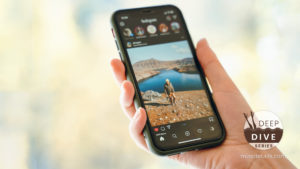
Welcome back to our Deep Dive series on building a brand from the ground up. If you haven’t read our earlier pieces in this series, I recommend going back to the beginning and starting from there! If you’ve been reading along, welcome back.
Your brand has hit the marketplace. Well done. You’ve already come a long way from your initial brand concepts: to continue the ‘building the house’ metaphor we’ve been using, you’ve gone from digging the foundation and pouring the concrete to putting up walls and a roof, and now you’ve got an inhabitable house.
But just because you’re able to move in and start enjoying your new space doesn’t mean all your work is done. In fact, if this is where you stop paying attention, you’ll quickly find yourself in the middle of a giant mess.
Quicklinks for the Full Deep Dive Series on Building a Brand
Part 1: Introduction | Part 2: Beginning Your Brand | Part 3: From Planning to Practice | 
To illustrate this point, let’s take a look at Tropicana. The orange juice giant made one of the worst branding miscalculations of the modern era when it changed its packaging in 2009, trading out the juicy orange on its box and its signature logo for a generic-looking glass of orange juice and a new logo and font. Nothing about the product changed, but sales plummeted 20% in a single month (a $33 million drop), a costly example of branding gone wrong.
It was a boon for their competitors, who saw products increase sales by double-figure percentages. Tropicana couldn’t switch back to their former packaging quickly enough.
Tropicana learned a valuable lesson that month: just because you have a successful brand doesn’t mean you can’t screw it up once it’s out in the real world. Brands need consistent attention over time; companies and marketing departments who neglect their brand and their customer base risk leaving themselves vulnerable to a major mistake if they try to change what already works. That doesn’t mean you should let your brand stagnate, but any changes should be intentional, with the customer’s preferences in mind.
Here are some ways to help ensure the strong brand concept and assets you put together stay relevant and maximize their value, exposure, and impact:

Define Your Success
What do you want to achieve?
It seems like a simple question. Every business, after all, has the same basic goals: to bring in enough revenue to offset costs (and then some); to promote its product or service; and to make an impact on its community, whether locally or globally.
But since your business and your brand are unique, so should be your measure of success. Do you want to increase your social media following by 1,500 followers each week? Do you want to decrease your customer acquisition cost by 20% over the course of a year? Would you like to double your retention rate? Your branding and marketing play a big role in all of those metrics. Setting goals helps motivate your team, gives you a mark to aim for, and allows you to focus your marketing efforts in ways that will help you reach those benchmarks.

Think Long Term
It’s tempting, especially in the early days and weeks of a brand launch, to focus only on the short term. And that’s certainly where you’ll have to spend the majority of your energy early on, especially as you’re tinkering with the response and maximizing your initial exposure.
But once you’ve got your original assets working for your brand, your social media channels pulling in followers, and your marketing team aligned on your values and voice, then it’s time for managers to start looking several months or years down the road. How will your goals change? How might your assets evolve? How often will you revisit your brand and voice guides and take an honest assessment of what still clicks and what doesn’t?
You don’t want to be stuck two years down the road still banking on your initial success, then suddenly realize you’re behind the curve.

Don’t Try to Be Like Everybody Else
The digital age has revolutionized branding. Even through the dawn of electronics and the era of radio and television in the mid-20th century, it could still take weeks or months—if not years—for a successful branding campaign to take hold in the public consciousness.
Now, branding success stories can happen seemingly overnight. New companies or initiatives can go from the launch stage to seven figures (or more) in a couple of weeks, or even faster, with a single viral social media post. Unfortunately, one brand differentiating itself with lightning-fast success often results in a slew of copycats. Take the case of Wendy’s, which brought some snark to its social media accounts, and quickly saw all sorts of fast food restaurants acting the same way.
As tempting as it can be to follow the crowd when something works, resist the urge to be just another brand in the mix. Analyze what worked about the lead brand’s pivot: why did it resonate with customers? What did they do to get noticed? Implement some of that in your own strategy, but find a way to add a unique spin.

The Customer is Always Right
We’ve all heard it countless times: The customer is always right. However, most people don’t understand what it means. In typical usage, “the customer is always right” tends to evoke the idea of a shopper’s happiness coming before anything else, even if it forces a business owner to bend over backwards to satisfy them. It was a response to the idea of caveat emptor (buyer beware), the maxim by which vendors of ill repute would rip off unsuspecting customers; the likes of John Wanamaker and other early 20th-century retailers wanted to ensure the customers that they would get premium treatment. But that’s not the main takeaway.
“The customer is always right” is a heads’ up for business owners to pay attention to their customers: they’re the ones who purchase the products, and therefore set the market. It doesn’t matter if you thought Product A was going to be your best-seller; if your customers flock to another one of your products, Product B, they are telling you what they want.
Take the case of Kendra Scott. She’s famous for her jewelry these days, but originally she only sold jewelry as a side business to her main product: hats. It took a while for Scott to realize that her customers were far more interested in her bracelets than her berets, but once she did, she started seeing results. If she had continued to fruitlessly push her customers towards hats and away from jewelry, she wouldn’t be the multimillionaire she is today.
So, when your customers tell you what they want, trust them—and if they keep asking you about a product or service that you don’t currently offer, consider adding it to your product or service line. The customers will tell you how they want to spend their money without even realizing it.

Keep an Open Mind
Throughout all of this, it’s critical that you don’t close your brand off to anything new or innovative. That doesn’t mean that you have to say ‘yes’ to everything, but it does mean you should remind yourself to hear ideas out and think them through to determine whether they might be good for your brand. That could mean a new social media channel or trend, a new affiliate partnership or endorsement, or any number of brand-related assets or touch points. The best marketing managers and CMOs put themselves in their customer’s shoes, understanding the best way to form connections with their base.
Whether your brand is new or has been out in the public consciousness for some time, it’s helpful to always keep an eye on the past as well as the future. If you can stay open-minded and analytical, respond to critique, and focus on your goals, you’re in good shape.
In the final piece of this Deep Dive series, we’ll go over all the lessons learned from this brand building debrief, and give you plenty to think about and apply to your business or start-up. Stay tuned to our blog, our sign up for our Brand Builders Newsletter below to stay up to date on all things marketing, branding, and more.
Don’t want to miss out on our articles and insights?
Sign up for the Miss Details newsletter today.
Learn More with our Deep Dive Series
About Miss Details
Founded by Tanya Gagnon in 2004, Miss Details is a full-service branding and design firm which helps entrepreneurs and companies launch, adjust and reinvent key aspects of their branding and business marketing strategy. With a background in all aspects of interior and experiential design and a passion for data-backed design, Tanya leads the Miss Details team to guide her clients through everything from a refreshed website to a full rebranding, helping them put the pieces together to create a consistent, authentic, unique brand image.



